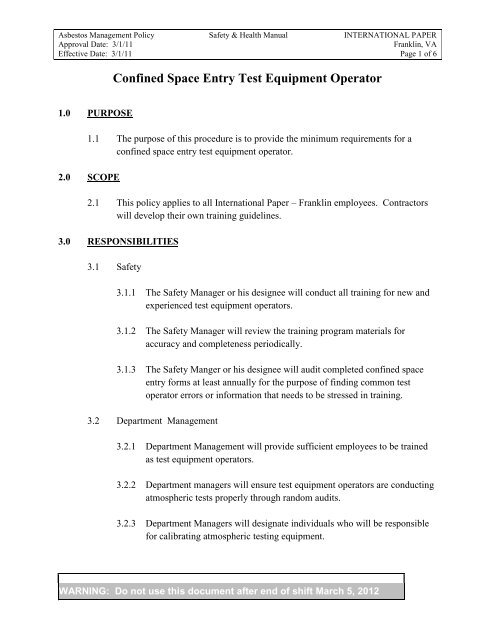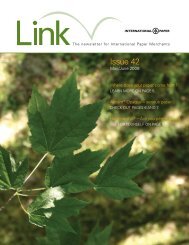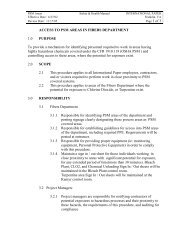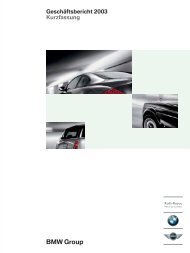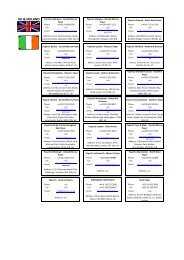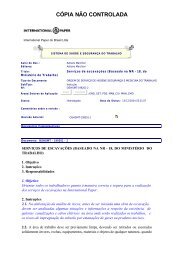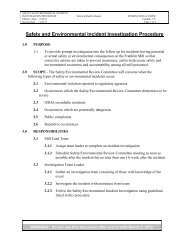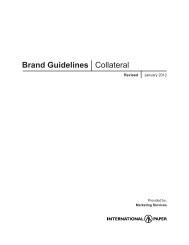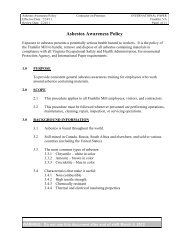Confined Space Entry Test Equipment Operator - International Paper
Confined Space Entry Test Equipment Operator - International Paper
Confined Space Entry Test Equipment Operator - International Paper
Create successful ePaper yourself
Turn your PDF publications into a flip-book with our unique Google optimized e-Paper software.
Asbestos Management Policy Safety & Health Manual INTERNATIONAL PAPER<br />
Approval Date: 3/1/11 Franklin, VA<br />
Effective Date: 3/1/11 Page 1 of 6<br />
1.0 PURPOSE<br />
<strong>Confined</strong> <strong>Space</strong> <strong>Entry</strong> <strong>Test</strong> <strong>Equipment</strong> <strong>Operator</strong><br />
1.1 The purpose of this procedure is to provide the minimum requirements for a<br />
confined space entry test equipment operator.<br />
2.0 SCOPE<br />
2.1 This policy applies to all <strong>International</strong> <strong>Paper</strong> – Franklin employees. Contractors<br />
will develop their own training guidelines.<br />
3.0 RESPONSIBILITIES<br />
3.1 Safety<br />
3.1.1 The Safety Manager or his designee will conduct all training for new and<br />
experienced test equipment operators.<br />
3.1.2 The Safety Manager will review the training program materials for<br />
accuracy and completeness periodically.<br />
3.1.3 The Safety Manger or his designee will audit completed confined space<br />
entry forms at least annually for the purpose of finding common test<br />
operator errors or information that needs to be stressed in training.<br />
3.2 Department Management<br />
3.2.1 Department Management will provide sufficient employees to be trained<br />
as test equipment operators.<br />
3.2.2 Department managers will ensure test equipment operators are conducting<br />
atmospheric tests properly through random audits.<br />
3.2.3 Department Managers will designate individuals who will be responsible<br />
for calibrating atmospheric testing equipment.<br />
WARNING: Do not use this document after end of shift March 5, 2012
Asbestos Management Policy Safety & Health Manual INTERNATIONAL PAPER<br />
Approval Date: 3/1/11 Franklin, VA<br />
Effective Date: 3/1/11 Page 2 of 6<br />
3.3 Employees<br />
4.0 DEFINITIONS<br />
3.3.1 Employees selected to conduct atmospheric testing will attend training and<br />
use proper techniques while conducting atmospheric testing.<br />
3.3.2 Employees must understand the operation of the test equipment and its<br />
limitations.<br />
3.3.3 Employees will keep their certification current.<br />
4.1 Detection Tube Device (e.g. Drager) - A device using tubes to monitor the<br />
concentration of certain gases within a confined space.<br />
4.2 <strong>Test</strong> <strong>Equipment</strong> <strong>Operator</strong> – An <strong>International</strong> <strong>Paper</strong> – Franklin employee has had<br />
been trained to operate the test equipment and whose last training date is not over<br />
two years old.<br />
5.0 REFERENCES<br />
5.1 <strong>International</strong> <strong>Paper</strong> - Franklin -<strong>Confined</strong> <strong>Space</strong> <strong>Entry</strong> Procedure<br />
5.2 <strong>International</strong> <strong>Paper</strong> - Franklin – <strong>Test</strong> <strong>Equipment</strong> <strong>Operator</strong> Training – PowerPoint<br />
Training<br />
6.0 PROCEDURE<br />
6.1 Department Management will assign employees to attend test equipment operator<br />
training. All employees are eligible to serve as test equipment operators.<br />
6.2 Training for selected employees will be given by the Safety Manager or his<br />
designee. This training will include all items mentioned in Section 7 of this<br />
procedure.<br />
6.3 Employees trained in this procedure will update their training every two years to<br />
stay certified.<br />
WARNING: Do not use this document after end of shift March 5, 2012
Asbestos Management Policy Safety & Health Manual INTERNATIONAL PAPER<br />
Approval Date: 3/1/11 Franklin, VA<br />
Effective Date: 3/1/11 Page 3 of 6<br />
6.4 <strong>Test</strong> <strong>Equipment</strong> <strong>Operator</strong>s will first ensure that their equipment has a current<br />
calibration sticker applied. Note: Continuous meters will have inspection<br />
stickers, detection tube devices will not have stickers. If the equipment is not<br />
current, properly calibrated equipment must be secured prior to conducting any<br />
testing.<br />
6.5 <strong>Test</strong> equipment operators will test their equipment in a clean environment prior to<br />
conducting atmospheric tests in a confined space.<br />
For continuous meters, these equipment checks will include:<br />
(1) Initial calibration of continuous type meters<br />
(2) Check on Pump Operation signal<br />
(3) Check on O2 sensor response (optional)<br />
(4) Use solvent marker for LEL sensor (optional)<br />
For detection tube devices, the device will be checked as follows:<br />
(1) Check on detection tube device air tightness (by insertion of unbroken<br />
detection tube into tip and trying to pump.<br />
6.5.1 As a minimum requirement, these checks will be completed on a daily<br />
basis.<br />
6.5.2 If any testing equipment does not work correctly, it must be replaced or<br />
repaired prior to completing any actual atmospheric testing for confined<br />
space.<br />
6.6 <strong>Test</strong> <strong>Equipment</strong> <strong>Operator</strong>s will conduct a review of the confined space internals to<br />
determine the scope of testing. The operator will use an extension pole or other<br />
means to ensure all areas of the confined space are included in the atmospheric<br />
testing.<br />
6.6.1 If there is possibility of stratification or pooling of air contaminants,<br />
atmospheric testing must be conducted every four feet in both the<br />
horizontal and vertical directions.<br />
6.6.2 Once testing from the outside has been completed and the paperwork has<br />
been properly completed, and a hole watch is in place, the test equipment<br />
operator may enter the confined space to conduct additional testing in<br />
WARNING: Do not use this document after end of shift March 5, 2012
Asbestos Management Policy Safety & Health Manual INTERNATIONAL PAPER<br />
Approval Date: 3/1/11 Franklin, VA<br />
Effective Date: 3/1/11 Page 4 of 6<br />
areas that could not be reached from the door. Should the alarm sound<br />
during this internal testing procedure, the test equipment operator should<br />
immediately exit the confined space and alert the entry supervisor. The<br />
confined space will need to be “treated” (additional air purging, washing,<br />
etc.) before re-entry is allowed.<br />
6.7 <strong>Test</strong> <strong>Equipment</strong> <strong>Operator</strong> will conduct all tests for the confined space that are<br />
required.<br />
6.8 Once atmospheric testing has been completed, the test equipment operator will<br />
clearly document his results on the confined space entry form and sign the form.<br />
The test equipment operator will compare the actual results obtained to the ceiling<br />
levels indicated on the form and place a check by the “safe” or “unsafe” for entry.<br />
6.8.1 The test equipment operator will inform the <strong>Entry</strong> Supervisor immediately<br />
if any of the atmospheric testing indicates a hazardous environment.<br />
6.9 The test equipment operator will then complete checks at least every hour after<br />
the initial check. These will then be documented on the confined entry form.<br />
6.9.1 Should the confined space be left unattended for any period of time, the<br />
test equipment operator will update the sniff prior to re-entry.<br />
6.9.2 Atmospheric testing will be conducted continuously for the following<br />
tasks:<br />
(1) Welding/cutting/hot work<br />
(2) Solvent cleaning<br />
(3) Painting<br />
(4) Scraping or de-scaling<br />
(5) <strong>Equipment</strong> exhaust in the area<br />
(6) In other cases where potential of hazardous atmosphere exists<br />
6.10 If the calibration on the equipment is nearing its end date, the employee will take<br />
this equipment to the storeroom and obtain a new set of equipment.<br />
WARNING: Do not use this document after end of shift March 5, 2012
Asbestos Management Policy Safety & Health Manual INTERNATIONAL PAPER<br />
Approval Date: 3/1/11 Franklin, VA<br />
Effective Date: 3/1/11 Page 5 of 6<br />
7.0 TRAINING<br />
7.1 Training will be conducted by the Safety Manager or his designee for selected<br />
employees.<br />
7.2 Training will include the following items at a minimum:<br />
(1) <strong>Confined</strong> <strong>Space</strong> <strong>Entry</strong> description<br />
(2) Why atmospheric testing is necessary (hazards already existing and<br />
changing conditions within space)<br />
(3) Training must be updated every 2 years<br />
(4) Proper operation of test equipment (multi-gas monitors as well as<br />
detector tubes )<br />
(5) Limitations of test equipment<br />
(6) Order of testing (oxygen first)<br />
(7) Duration of testing (how long to run meter before taking reading)<br />
(8) Checking calibration of test equipment<br />
(9) <strong>Equipment</strong> checks prior to conducting testing (See Section 6.5)<br />
(10) How to properly test confined space environments (may need<br />
extension pole or complete more extensive testing)<br />
(11) Discussion on cross sensitivities/interferences<br />
(12) How to check test results and then enter them on the confined<br />
space entry form<br />
(13) What to do if atmospheric testing shows a hazardous atmosphere<br />
(14) How often testing must be completed after initial entry<br />
requirements are completed<br />
(15) When continuous monitoring is required<br />
(16) Specific details about O2, LEl, H2S, CO, CLO2, SO2, NOx, etc.<br />
(17) Permissible exposure limits for each contaminant<br />
7.3 Sufficient training will be completed to keep enough test operators current to meet<br />
annual outage requirements.<br />
8.0 DOCUMENTATION<br />
8.1 The Safety Department will keep an updated list of test equipment operators and<br />
their certification date.<br />
WARNING: Do not use this document after end of shift March 5, 2012
Asbestos Management Policy Safety & Health Manual INTERNATIONAL PAPER<br />
Approval Date: 3/1/11 Franklin, VA<br />
Effective Date: 3/1/11 Page 6 of 6<br />
9.0 APPROVAL AND ISSUE<br />
This procedure is approved by the Franklin Lead Team<br />
10.0 REVISION HISTORY<br />
DATE MODIFICATIONS<br />
Mar 1, 2011 New<br />
WARNING: Do not use this document after end of shift March 5, 2012


